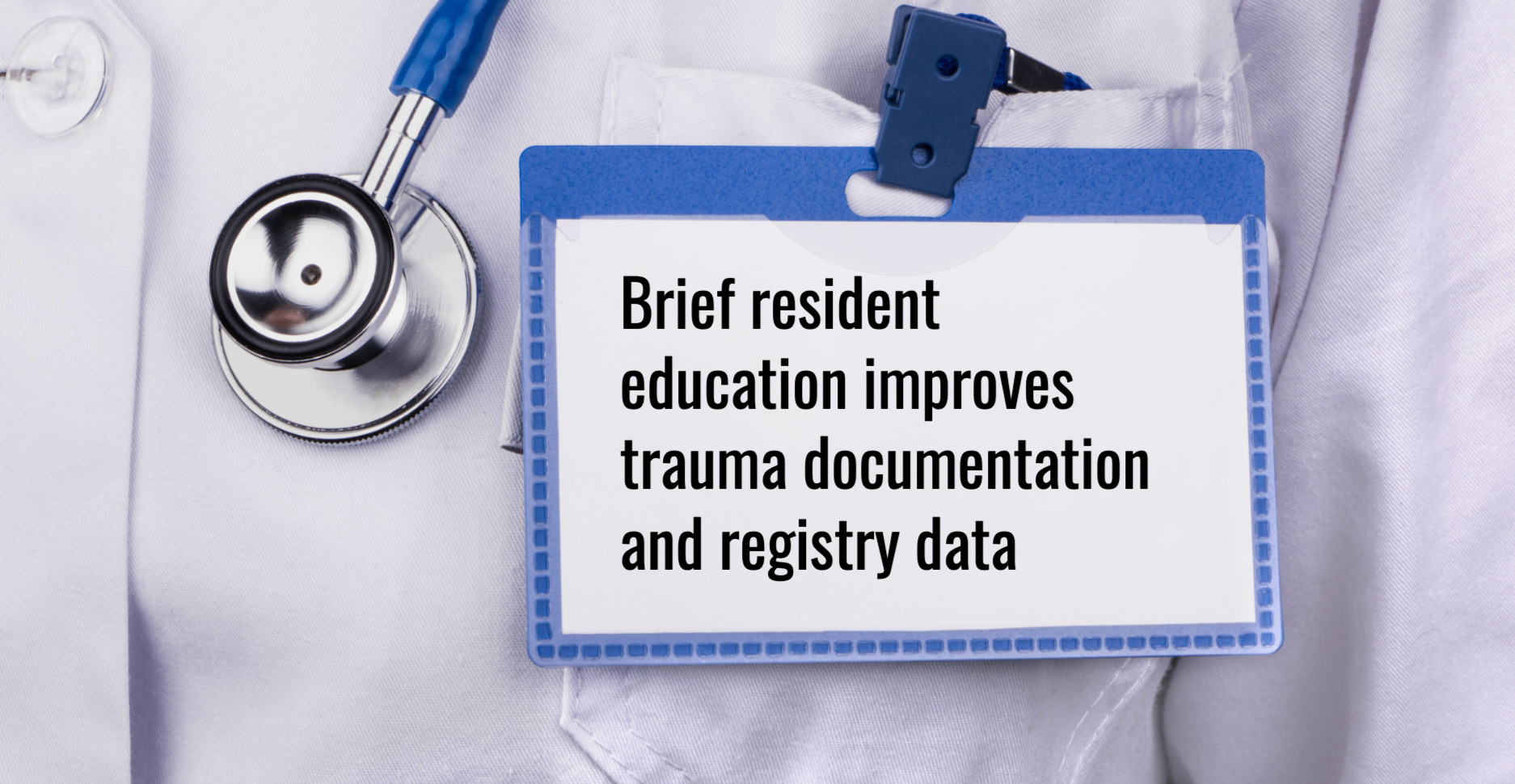Complete and accurate documentation is essential to high-quality trauma registry data. Unfortunately, physicians are often not well instructed in the specific requirements of trauma registry documentation. This can be especially challenging in hospitals with active residency programs.

This was a challenge we faced at Jefferson Abington Hospital, a Level II trauma center in suburban Philadelphia. Our trauma providers have always been dedicated to achieving high performance in every aspect of patient care, including clinical documentation, yet our trauma registrars spent a lot of time tracking down additional information from them. As we on the registry team sought the information needed to accurately abstract charts and code data, we were often left with more questions than answers.
Addressing this issue was important to the registry team, because we are entirely focused on capturing quality trauma data. It was also important to me personally, because I have experienced firsthand the importance of data quality in trauma care.
When I was 10 years old, my younger brother suffered a potentially devastating playground injury. I waited with my mother and father at this same hospital as the trauma team raced to give him the best care possible.
In the years since, I have learned a lot about what went on behind the scenes (more on that below), but the lesson I carry with me every day is that quality trauma care depends on quality trauma data.
So how did we address our challenge with resident documentation? We realized in early 2019 that we needed a way to quickly bring residents up to speed on documentation basics. Our solution was to foster a closer connection with residents by providing brief upfront education on trauma data and documentation requirements of the state and national trauma registries.
Our brief trauma documentation education for residents
Our resident education intervention has two components — an initial meeting with registry staff and an information packet that residents can use for ongoing reference. Since this initiative started before the pandemic was ever a thought in anyone’s mind, our first information packet was a paper-based resource and all meetings were conducted in-person.
The information packet provides key registry definitions, focusing on the most important documentation issues from various sections of the registry — for instance, hospital events, diagnoses, call times, etc. It also provides examples of adequate and inadequate documentation.
- Examples of unsatisfactory documentation include missing call times to other services during the resuscitative phase (in the H&P) and unclear diagnoses (for instance, failure to document which ribs are fractured or which pulmonary lobes have a contusion).
- Examples of quality documentation include clear and concise explanations of several injuries, especially rarely seen injuries, and clearly documented past medical history, especially clarity on which specific anticoagulant(s) the patient takes.
The initial meeting with residents takes place near the beginning of their trauma rotation. During this group meeting, a member of the registry staff provides a brief but important explanation of why we are focused on data quality. The goal is to give residents a greater appreciation for how quality data leads to quality research and ongoing improvement in trauma patient care. Residents also receive a copy of the trauma documentation information packet during the initial meeting.
We found that residents ask wonderful questions during educational meetings with registry staff. We also found that these meetings lay the groundwork for a productive relationship. After the program was introduced, the registry team started to receive emails from residents asking specific questions about how to document various cases. At the same time, residents became more responsive to inquiries from the registry on needed clarifications.
How we modified the program for pandemic distancing
When the COVID-19 pandemic hit, we were forced to put our resident education project on hold for over a year. When we were able to pick it back up in May 2021, we decided to digitize and streamline the process for even easier delivery to our residents.
- First, we converted our paper information packet to a PDF document that provides largely the same information.
- Second, we created a PowerPoint presentation that functions as a condensed version of the information packet. We use the presentation to guide discussion during resident meetings and highlight the most important registry items for improvement.
- Third, we converted the in-person meeting to a remote conference via Zoom.
- Finally, we created an online attendance survey (using Qualtrics) that allows us to track which residents have met with the registry team.
The all-digital version of our intervention continued to produce positive educational results and improvement in documentation. In addition, the virtual format has allowed us to meet with more residents than before. In the past, residents had to come to the trauma program offices across campus to complete their registry education. Now, they are more readily able to find a break in their day and connect with us easily over Zoom from wherever they are in the hospital.
Outcomes and lessons learned
Our resident education intervention is a continually evolving project. Subjectively, we have already seen improvements in documentation, in the quality of the conversations that take place between the registry team and the rotating trauma residents, and in the quality of our data abstraction. Since the program was first introduced, we have noted a decrease in the number of charts lacking sufficient detail and a decrease in the amount of time registrars must spend on data clarification inquiries.
The program has led to one additional benefit. Our hospital transitioned to a new EMR system in February 2021. As is normal for any EMR transition, learning and growth were necessary. Our education intervention has served as a tool for educating residents on system-specific documentation changes. It has also allowed to focus residents on the most important documentation improvement needs for our registry within our new EMR.
Utilizing this project, our goal is to address EMR documentation uncertainties as they occur rather than retrospectively after the patient is discharged and the registry chart is closed. In a manner of speaking, we want to “stop the bleed” sooner regarding documentation that needs improvement.
Overall, there were several lessons learned.
- First, this program can be successful both in person and virtually. In fact, the virtual option has allowed us to increase the number of residents we reach.
- Second, this program has fostered a better personal connection between our residents and our registry staff. As noted, the intervention has led to many useful and productive conversations that result in better trauma documentation.
- Third, inviting residents to understand a bit more about the trauma registry allows for a full circle of understanding. When residents ask for data to complete research, they understand where it comes from, why there may be missing data and other key issues.
As we enter a site survey year, our trauma program intends to continue this resident education program as an important part of our data quality plan.
A personal view of data quality
As I wrote above, one reason this project is important to me is that I have personally experienced the importance of quality trauma data.
My brother’s playground accident left him with a severe spine injury, and he was paralyzed for several days. I am grateful to say that my brother not only survived, but recovered with no long-term disability — thanks in no small part to the efforts of quality-focused trauma providers backed by a data-driven approach to quality care.
So I am very aware of just how important data and research are for the care of our trauma patients. Quality data analysis can only come from quality data, and data improvement projects — like our resident education program — are key to improving the quality and efficiency of trauma patient care.
Jennifer Hopp is Trauma Registrar at Jefferson Abington Hospital, a Level II trauma center in Abington, Pennsylvania.

